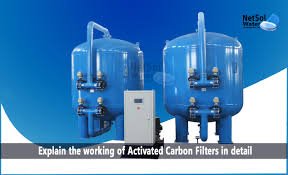Activated Carbon Filter and Increase in Efficiency for Water System

Activated Carbon Filter in Water System
1. Introduction
Activated Carbon (AC) filters are widely used in Purified Water (PW) and Water for Injection (WFI) pre-treatment systems.
They are installed after multimedia filters and before softeners/RO systems.
Main function: Removal of organic impurities, chlorine, chloramine, taste/odor compounds, and some heavy metals from raw water.
2. Principle of Working
-
Adsorption: Activated carbon has a large surface area (800–1500 m²/g) due to its porous structure. Organic molecules, chlorine, and chloramine get adsorbed on the surface.
-
Catalytic reduction: Chlorine is removed by catalytic reduction, forming chloride ions.
-
Physical filtration: Suspended matter and colloids may also get trapped in pores.
3. Role in Pharmaceutical Water Systems
-
Protects RO membranes from oxidation by chlorine/chloramine.
-
Reduces TOC (Total Organic Carbon) load.
-
Improves taste and odor (important for oral formulations).
-
Ensures compliance with pharmacopeial standards for purified water.
4. Factors Affecting Efficiency
-
Contact time: Adequate Empty Bed Contact Time (EBCT) of 5–10 minutes is required.
-
Flow rate: Should be optimized; too high reduces adsorption efficiency.
-
Particle size of carbon: Smaller particles provide larger surface area → higher efficiency, but cause higher pressure drop.
-
Water quality: Higher organic load reduces life of AC filter.
-
Backwashing: Regular backwash is needed to avoid channeling and clogging.
-
Microbial growth: Carbon beds can support microbial proliferation → sanitization (hot water/steam/chemical) required periodically.
5. Methods to Increase Efficiency
-
Optimize EBCT (5–10 minutes): Ensure adequate contact between water and carbon.
-
Use high-quality activated carbon: Coconut shell-based AC offers better adsorption than coal-based.
-
Regular backwashing: Prevents channeling and maintains effective surface area.
-
Periodic sanitization: Use hot water (≥80 °C) or chemical agents (e.g., sodium hypochlorite, hot ozone) to control biofilm.
-
Proper pre-filtration: Install multimedia/sand filters before AC filter to reduce suspended solids load.
-
Monitor pressure drop: Replace AC media when pressure drop increases beyond limits.
-
Dual filter design: Use two AC filters in series for high chlorine load situations.
-
Scheduled replacement: Typical AC bed life is 6–12 months, depending on raw water quality.
-
On-line monitoring: Regular testing of chlorine, TOC, and microbial load to confirm effectiveness.
6. Validation & Monitoring
-
Test influent and effluent water for chlorine, TOC, microbial counts.
-
Establish replacement frequency based on performance qualification data.
-
Continuous monitoring of chlorine breakthrough ensures RO membrane protection.
✅ In short:
Activated carbon filters in pharmaceutical water systems adsorb chlorine and organic impurities, protect downstream RO units, and reduce TOC. Their efficiency can be increased by optimizing contact time, regular sanitization, pre-filtration, dual filter design, and scheduled carbon replacement.
🎓 Discover one of the best Pharmaceutical Microbiology course available —click below to explore the course that’s shaping future Microbiology course skills.

